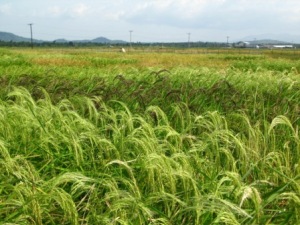Cultural practices for characterization of cultivated rice
Contributors to this page: T.T. Chang Genetic Resources Centre-IRRI, Los Baños, Philippines (Ruaraidh Sackville Hamilton, Ken McNally, Flora de Guzman, Renato Reaño, Soccie Almazan, Adelaida Alcantara, Elizabeth Naredo); WARDA, Cotonou, Benin (Ines Sánchez); UPLB-University of the Philippines at Los Baños (Teresita Borromeo).
Planting and cultural practices
Environment
 Characterization trial of rice (photo: IRRI) |
- For large diverse collections encompassing varieties from different ecosystems, use irrigated lowland with good drainage (this provides a single common environment suitable for growing and comparing almost all varieties, including upland, lowland and deep water varieties, regardless of their normal ecosystem and adaptation).
- For collections targeted to particular ecosystems, use the corresponding ecosystem (matching the ecosystem to the target provides more realistic characterization of varieties adapted to that ecosystem).
Note: In rice agriculture, the terms ‘upland’ and ‘lowland’ conventionally refer to the type of cultivation, not to the elevation of the land. Thus it is possible (and common) to have ‘upland’ rice in the lowlands and ‘lowland’ rice in the uplands.
‘Upland’ = on sloping land never inundated in water.
‘Lowland’ = on level ground periodically inundated, by rainfall or by irrigation water, to control weeds.
Soil type
- Silt clay to clay loam (best for lowland rice cultivation).
Rainfall
- Medium-high, or irrigate (rice does not grow well under drought; it needs either abundant rainfall or effective irrigation).
Season
- As appropriate to rice cultivation in the region.
- In tropical areas with two cropping seasons per year, select one season per year for characterization: usually the season that starts while days are growing longer.
- Long-duration varieties will extend into the second cropping season (using one fixed season each year improves consistency between trials.
- Some rice varieties are short-day photoperiod sensitive.
- In tropical latitudes higher than about 10°, the sensitivity to photoperiod (a key trait) can be tentatively characterized without multiple treatments by planting as the days are growing longer (e.g. in April-May in the northern hemisphere, October-November in the southern hemisphere); photoperiod sensitive accessions then remain vegetative for a prolonged period until the days shorten again. However, this does not distinguish between photoperiod-sensitive and long-duration photoperiod-insensitive varieties).
Plot size
- 5 m2 - 3 rows 5 m long (minimum plot size providing one row for sampling and one border row on each side).
Sampling area/border area
- Sampling area - one central row.
- Border area - one row on the edge of each plot, i.e. two border rows between successive sampled rows (minimum area good enough to record required traits at minimum maintenance cost).
Plant density
- Single seedling per hill, 30 x 30 cm between hills (use wider spacing than common agricultural practice for improved recording of tillering ability).
Replications
- Normally unreplicated entries, control varieties are replicated every 150 entries (replication of only control varieties is sufficient for normal assessment of highly heritable morpho-agronomic traits; more economical and thus allowing the screening of more accessions).
- For special purpose characterization for more rigorous statistical analysis, full replication is necessary.
Standard check cultivars
- For large diverse collections spanning all types, use up to six control varieties from the main taxonomic variety groups (glaberrima, indica, japonica, aus) and morpho-agronomic groups (glutinous, semi-dwarf).
- For smaller collections targeted at a particular ecosystem or environment, use a smaller number of check cultivars as appropriate for the target ecosystem and environment.
Frequency of standard checks
- Plant the full set of selected check varieties every 150 entries (this is the best practices considering the number of entries being handled and randomly scattered across the entire size of the field).
Time of day for data collection
- Field data are best collected in the morning (best time for consistent characterization of traits such as flowering that vary through and are most apparent in the morning. Best time also for the effectiveness of the observer).
- Post-harvest data can be taken any time, but for efficient use of time, good practice is to alternate field work in the morning with post-harvest characterization indoors in the afternoon.
Consult the general rice characterization page for information about descriptors, or recording of information during characterization.
References and further reading
Hanson J. 1985. Practical Manuals for Genebanks: Procedures for handling seeds in genebanks. IBPGR,
Rao NK, Jackson MT. 1996a. Seed longevity of rice cultivars and strategies for their conservation in genebanks. Annals of Botany 77:251–260.
Rao NK, Jackson MT. 1996b. Seed production environment and storage longevity of japonica rices (Oryza sativa L.). Seed Science Research 6:17–21.
Rao NK, Jackson MT. 1996c. Effect of sowing date and harvest time on longevity of rice seeds. Seed Science Research 7:13–20.
Rao NK, Hanson J, Dulloo ME, Ghosh K, Nowel D, Larinde M. 2006. Manual of seed handling in genebanks. Handbooks for Genebanks No. 8. Bioversity International, Rome, Italy. Available in English (1.5 MB), Spanish (1.4 MB) and French (1.9 MB).
Reaño R, Pham JL. 1998. Does cross-pollination between accessions occur during seed regeneration at the International Rice Genebank? International Rice Research Notes 23(3):5–6.
Reed BM, Engelmann F, Dulloo ME, Engels JMM. 2004. Technical guidelines for the management of field and in vitro germplasm collections. Handbook for Genebanks No. 7. IPGRI, Rome, Italy. Available here.
Sackville-Hamilton NRS, Chorlton KH. 1997. Regeneration of accessions in seed collections: a decision guide. Handbook for Genebanks No. 5. IPGRI, Rome, Italy. Available here.
Van Soest LJM. 1990. Plant Genetic Resources: Safe for the future in genebanks. Impact of Science on Society 158:107-120.
Comments
- No comments found





Leave your comments
Post comment as a guest